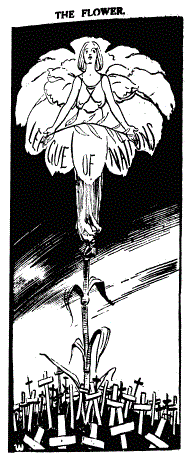|
| |
|
There is only one power to put behind the liberation of mankind, and that is the power of mankind. It is the power of the united moral forces of the world, and in the Covenant of the League of Nations the moral forces of the world are mobilized. President Woodrow Wilson, speaking in September 1919.
Formation and CovenantThe League of Nations was set up because President Wilson wanted this more than anything else. He wanted the League to be a kind of ‘world parliament’, where nations would sort out their arguments. He hoped this would stop wars. But Wilson wanted to do more than just stop war; he wanted to make the world a better place. He wanted the League to do things to improve people’s lives and jobs. He wanted to improve public health, and to end slavery. He hoped that the League would persuade the nations to agree to disarmament – to put down their weapons. That would make war impossible. And, finally, Wilson thought that the League of Nations could enforce the Treaty of Versailles, and persuade countries to keep the promises they had made. Wilson’s general principles were knocked into shape at the Paris Peace Conference. Two members of Loyd George’s team – the British lawyer Robert Cecil and South African statesman Jan Smuts – made significant contributions. Then a draft Covenant was prepared by British international lawyer Cecil Hurst and US treaty expert David Miller.
|
Going DeeperThe following links will help you widen your knowledge: Photographs of the League HQ in Geneva. The League's Aims, as shown in the Covenant. Wilson's speech in favour of the League.
What was the LoN?You are about to study an amazing, world-changing organisation.
|
|
The Aims of the League [SIDE] ... were enshrined in the Covenant of the League of Nations, which was signed on 28 June 1919, and can be summed up as: • Stop wars, • Improve people’s lives and jobs, • Disarmament, • Enforce the Treaty of Versailles (including resolving the problem of Reparations). The first meeting took place in Paris on 16 January 1920 … though in November 1920 the League moved its HQ to Geneva in neutral Switzerland.
Source AThe League of Nations has its roots in a popular support far deeper and firmer than shifting governments. To the peasant in France, with the horror of the war seared in his memory, it represents the symbol of a new hope. To the worker, the League's labor office, under the leadership of Albert Thomas, is the promise of a better fortune. The League stands for disarmament, for peace, for international justice, for the protection of backward peoples, for a better standard of living, for the relief of suffering, for the fight against disease, and for all the other forward-looking policies bound up in the longings of mankind for a better world-policies which the people everywhere in Europe, as distinguished from their governments and leaders, are unwaveringly supporting. The people understand the League; at least they know what it aims to accomplish. Raymond Fosdick, writing in the Atlantic Monthly (Oct 1920).
Source BWhy did the League fail? I can tell you in a word: Wilson. Head in the clouds, so high-minded that he was no earthly use – it failed while it was still in his mind. Its aims were dreams – stop wars, make the world a better place... They were beyond God, never mind the League. Written by a modern historian (2004). .
|
Source C
This picture by the British cartoonist David Low appeared in the Star newspaper on 11 November 1919 Click here for the interpretation
|
Consider:1. Imagine you are Wilson, talking to Clemenceau and Lloyd George. Tell them about your idea for the League of Nations, what it would do, and how it would work. 2. Read Sources A and B, then consider the League's aims: were the League's aims too ambitious?
|
|
|
| |
